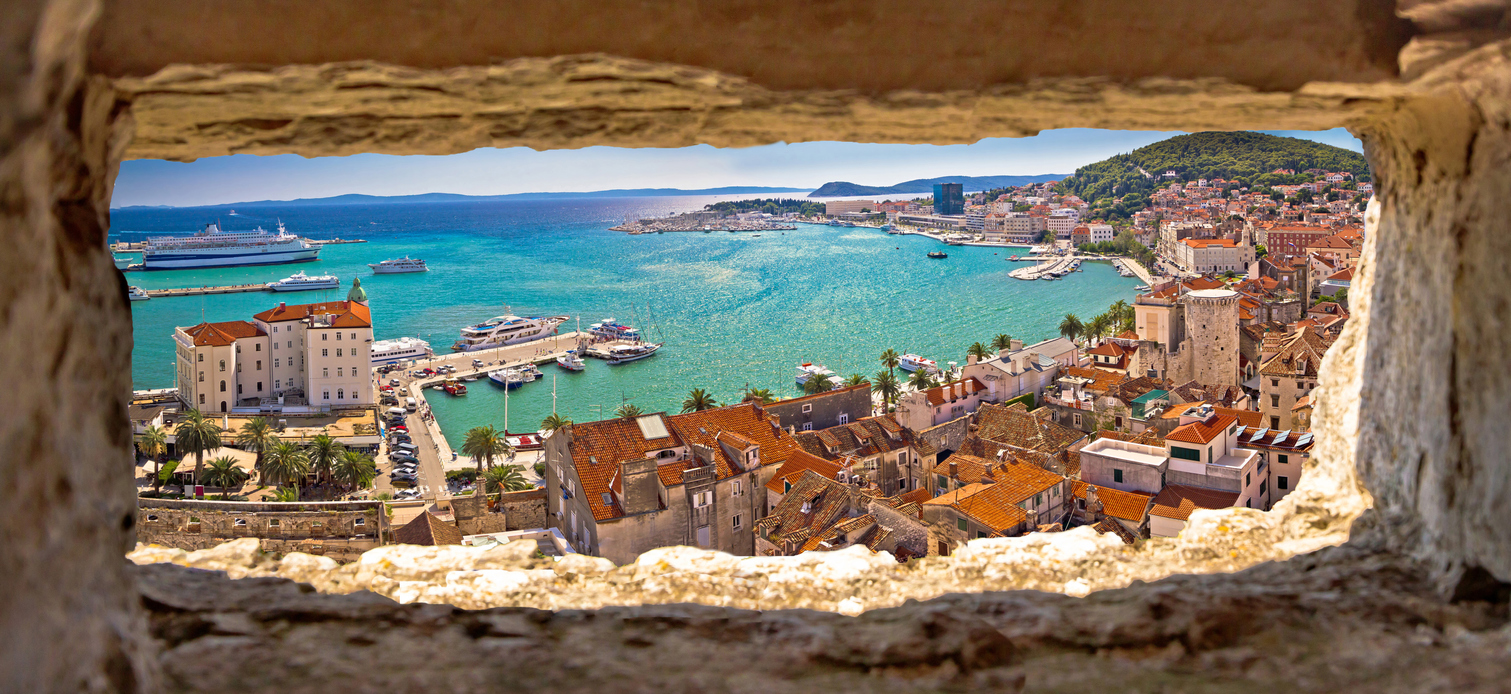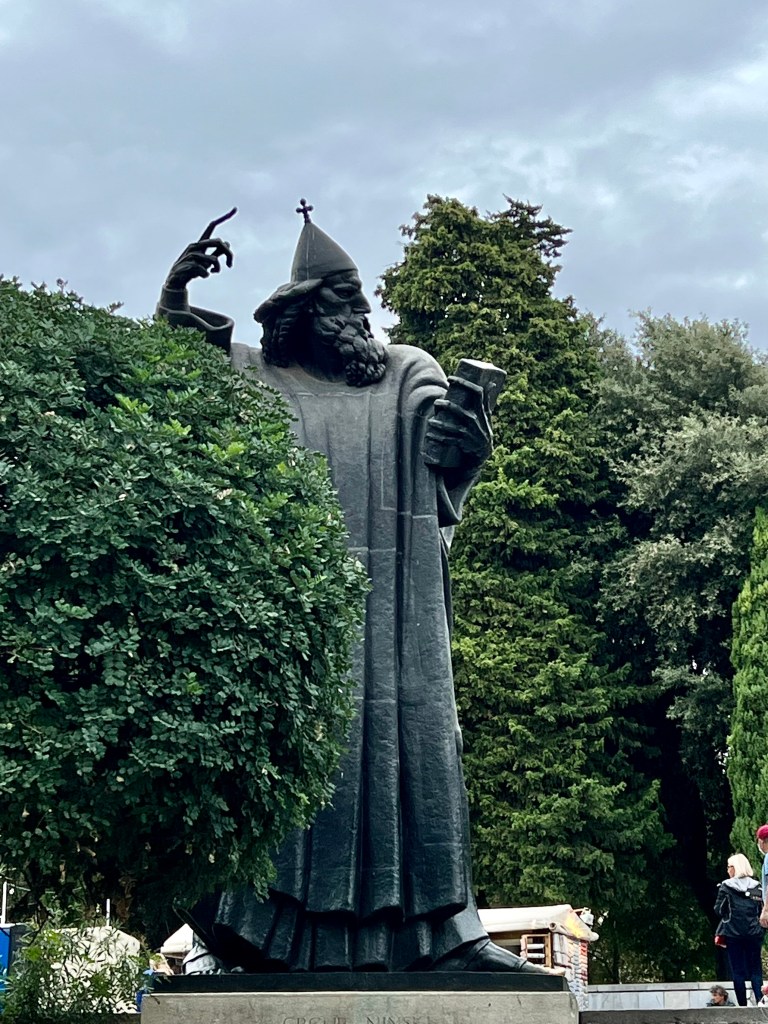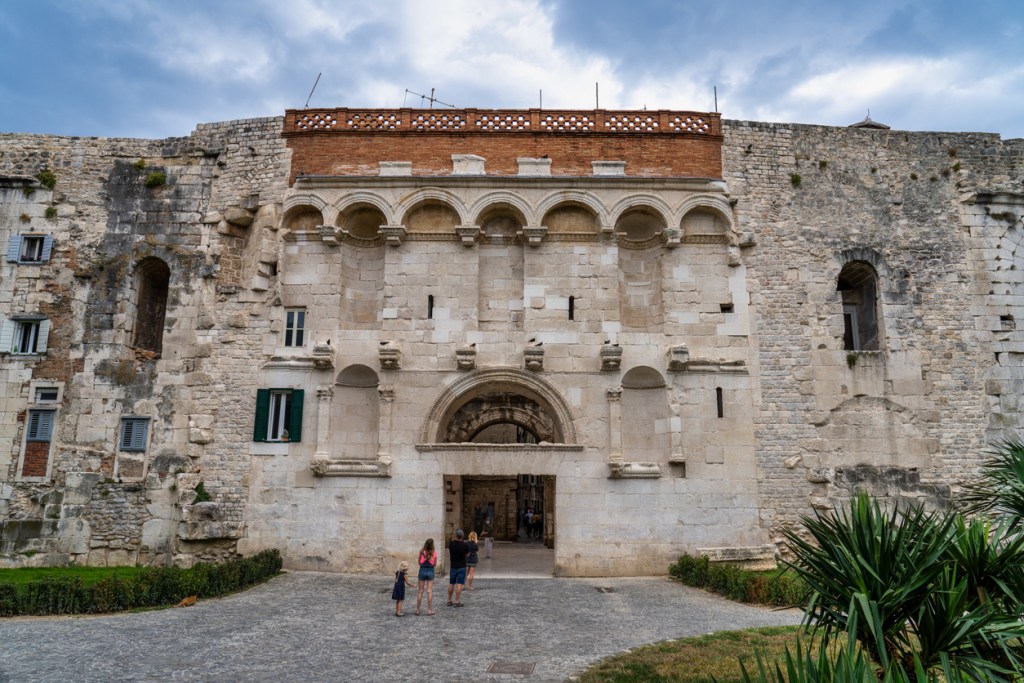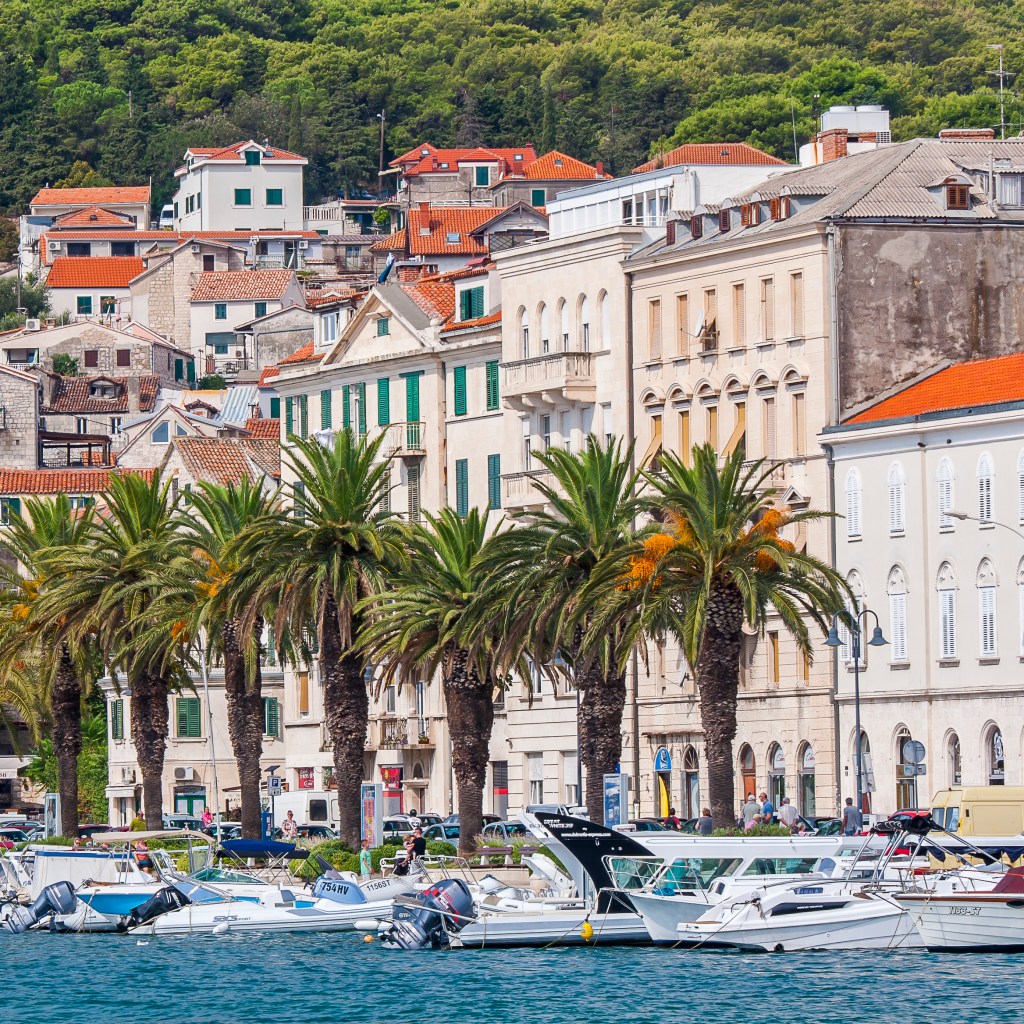
Table of Contents
While Croatia’s Dubrovnik steals the spotlight with its Game of Thrones grandeur, Split is where a Roman emperor lounged in an opulent palace, a medieval bishop preached defiance, and gladiatorial roars once echoed in a nearby arena.
Wander cobbled streets where history hums from beneath your feet, from the whispers of Diocletian’s mausoleum to the clinking of spoons in taverns within centuries-old buildings. Split invites you to touch the rough edges of history, where every weathered stone whispers a forgotten tale.
Date of Visit: September 23-25, 2022
Croatia's Imposing Bishop Gregory of Nin
“Rub his big toe for good luck,” said our tall, impossibly thin Croatian guide, Marija. We walked toward Bishop Gregory of Nin (aka Grgur Ninski), his bearded head and pointy medieval hat poked clownishly above the tree tops toward the threatening gray sky.
Marija’s toe-rubbing suggestion would have been an awkward request had the man with the lucky toe not been a 28-foot-high (8.5 meters) bronze statue. The imposing monument stands just outside the Golden Gate, one of four intact Romanesque stone gateways built into the walls of Diocletian’s Palace in Croatia’s historic Split.


Centuries collide in Croatia and other parts of the world, unlike where I live in California. There is nothing remotely like ancient or medieval Europe in America, where only a handful of native Indian stone dwellings date to the pre-Columbian era (before Christopher Columbus). That may be why I’m fascinated by relics left by ancient conquering armies and navies.
The Ancients Before Gregory
Croatia was the stomping ground of the ancients (Illyrians, Greeks, Celts, and Romans) before the Slavs, Venetians, Habsburgs, and Hungarians came in the Middle Ages. The Habsburgs stayed for centuries, fighting invading Ottoman armies in the 16th and 17th centuries. These historical timelines overlap in the placement of statues and the natural eclectic architecture of towns and cities.
Split is an excellent example of this historic mishmash. Here, you can walk under decorative Venetian balconies overhanging narrow Roman cobbled streets. You will invariably pass well-preserved Gothic-Renaissance, Venetian, and Roman buildings tucked behind tiny courtyards, some with tables set out to serve tourists.


Most of us barely stop to think about the time warp from one building to another. But sitting at my computer, sorting the visit in my mind, I find it remarkable how seamlessly the Old Town (Stari Grad) of Split blends history.
Gregory Is A Croatian Hero
But I digress. Let’s return to the medieval Bishop we left before we entered the Palace walls. He was born long after the death of the Palace’s anti-Christian Roman namesake, Diocletian. Yet, there he stands as if part of the Roman empire.
Unlike the ruthless Diocletian, Bishop Gregory of Nin is a Croatian national hero who famously disobeyed the Vatican in 926 AD by giving sermons in Croatian rather than Latin, a language understood only by the most highly educated Slavs in the Kingdom of Croatia.

Spreading Catholicism in Croatia
By making his sermons understandable to the masses, the rogue Bishop helped spread Catholicism to this once-tribal nation that, during Diocletian’s time, worshiped a pantheon of gods before embracing Catholicism. Croatia is 86 percent Catholic today. (See Country Profiles in Travel Resources). What a difference 1,700 years can make, eh?

The Bishop’s sandaled left foot protrudes beneath his heavy bronze robe, seemingly there for the rubbing. And yet, it’s hard to imagine that is what Croatian sculptor Ivan Meštrović intended when he cast the statue in 1929. The Bishop’s toe has turned a golden hue from all the attention, not just from tourists but also from locals.
“I don’t believe it brings good luck, but why not?” Marija said with a laugh. Her English is perfect. Her let’s play it safe advice is one of the reasons this myth lives on.
“Go stand by him; I’ll get a picture,” said my husband impishly. “Let me take a photo of both of you,” said Marija, reaching for my phone to digitize a tourist rite I could post on social media. Obediently, we sidled up to the Bishop for Marija’s impromptu photo shoot.
Has the toe polishing brought us luck? The jury is still out.
Unlucky Christians
Having hedged our bets, we stepped into the retirement residence of the unpleasant Roman Emperor Diocletian (245-313 AD). Depending on who you ask, he wasn’t all bad. If you weren’t a Christian or slave forced to build his palace retreat on Split’s shores, he was a tad better than Caligula, Nero, and a few other notorious Roman emperors. After all, he helped save the Roman Empire from collapse after nearly 50 years of strife, appointed a co-emperor, and presided over the Eastern Empire until his retirement in 305 AD.
The problem is Diocletian didn’t much like Christians. He killed several thousand during his reign in the late 3rd and 4th Centuries AD. Many died horribly after being tortured in front of spectators in an Amphitheater several miles away in Salona (now Solin). See the Salona section at the bottom of this post.

UNESCO World Heritage
Aside from all that unpleasantness, Diocletian’s Palace, built for his retirement years, is truly a marvel. In truth, it looks more like the remains of a fortress than a palace. It is considered one of the best-preserved Roman ruins in the world. It has been on the UNESCO World Heritage Sites list since 1979, one year after the esteemed United Nations’ list of natural and cultural treasures came into being.
Game of Thrones Film Site in Croatia
And I would be remiss if I didn’t give a nod to popular culture. Game of Thrones fans will be interested to know the directors filmed several scenes from the hit television series at Diocletian’s Palace. Its old Roman buildings and narrow passageways served as a site double for nearby Klis Fortress, which was the setting for Meereen in the fictional kingdom of Westeros.

Diocletian’s cellars made perfect “stables” for two of Daenerys Targaryen’s terrifying dragons. Also filmed here were the “Kill The Masters” slave revolt and the murder of the honorable and beloved Ser Barristan Selmy.
If you aren’t a GOT fan, all you need to know is that the palace setting was ideal for reimagining a period that drew from antiquity but which served as a backdrop for fantasy. Last I checked, there were never dragons in Split.
Palace Walk
The walls of Diocletian’s Palace, within Split’s Old Town, are bordered by the Aegean seafront to the south and a park to the north.
The Palace is a twisty ramble through the Old Town’s narrow streets. Visitors can enter and exit freely through four gates named after metals: Iron (west), Brass (south), Silver (east), and Gold[den] (north) gates. The gates are long gone, but the stone archways are intact.

I’d love to know how the gates came by their names. After Diocletian passed, the Palace changed hands numerous times after the locals moved in. The gates likely earned their names in the medieval period or later.
Peristyle Square - The Main Drag

At the heart of the Palace is Peristyle (Peristil) Square, which looks like it fell out of a Hollywood set for Gladiator. It is framed on two sides by the octagonal Cathedral of St. Dominius (originally Diocletian’s Mausoleum) and, on the other, by steps leading down to expansive cellars once filled with seawater, freshwater and a sulfur spring, but now housing vendors selling everything from sea shells, colorful ceramics, prints to refrigerator magnets, beaded jewelry, and sandals.

We arrived late afternoon, and the place was still a hive of activity.
Tourists strolled through the square, some jostling for camera angles and others taking it all in. A few day drinkers sat atop Lvxor Café and Restaurant’s plush cushions on the stone steps, sipping cocktails and watching the action that included grown men in Roman outfits wielding swords and taking money from tourists like me.
Notwithstanding the sightseers, cocktails, and the tourist information office, I felt transported back in time.

Even with a glass-framed illustration of the former Palace on a nearby wall, it takes a bit of imagination to envision how the crumbling complex once housed Diocletian’s private quarters and a military garrison. The imperial apartments were on the upper floor, which has long since disappeared. However, we have an idea of their magnificence.
Archeologists speculate that Diocletian’s living quarters resembled the cavernous spaces and arched ceilings of the cellars you can still walk through.
Diocletian kept the water view for himself. The water level no longer laps against the palace walls; today, a promenade separates the Palace from the harbor.
The military barracks were located on the northern side of the Palace near the Golden Gate, facing Salona, the capital of Dalmatia. If there were to be trouble, that is the direction it would come from. Historians figure the military accounted for half of the Palace’s 33,000 yards (30,000 sq meters).
Somewhat surprising for an archeological site are all the shops, cafes, restaurants, and apartments operating out of the old buildings within the Palace. About 3,000 people live within the open boundaries of Diocletian’s Palace today, and tourists can book accommodations here.
Cathedral of St. Dominius/Diocletian's Mausoleum
Diocletian’s mausoleum is like a Russian matryoshka nesting doll.
The Cathedral of St. Dominius sits inside the mausoleum, a structure dating back to AD 305. When the Western Roman Empire collapsed in AD 476, the Byzantines promptly tossed out Diocletian’s remains.
In the 7th century, the church consecrated the mausoleum as a Cathedral. Ironically, the mausoleum became the “Cathedral of St. Dominius” in deference to Bishop Dominius of Salona, whom Diocletian inadvertently martyred.


The Bell Tower

If you’ve closely followed our Croatia adventures, you’ll know that Chris and I can never resist a bell tower.
We ascended the 183 steps of the Cathedral’s bell tower, originally built in the 13th century and reconstructed in the early 20th century, to see the cityscape.
It was worth it, even with my badly swollen leg from the horse wreck days before.
The Treasury
A Treasury room across from the Cathedral houses a valuable ecclesiastical collection, including gold chalices, paintings, and the oldest illuminated Croatian manuscript. Over the years, the Catholic Church collected these relics from various parts of Europe to place them in this, the oldest church in Split. The Treasury room sits on the site of a Roman pagan temple dedicated to the mother goddess Cybele.

The Cellars
The Bronze Gate and steps at the southern end of the Peristyle lead down to the cellars next to the Cathedral. These vaulted cellars (aka substructures) once propped up Diocletian’s living area. Before modern-day merchants set up their kiosks here, the cellars were a source of fresh and thermal springs for Diocletian. When the townspeople moved in during the Middle Ages, they used the cellars as a dump.
Traces of Egypt
Diocletian became fascinated by all things Egyptian during his campaigns in the Middle East. That explains the sarcophagus he chose to be buried in when he died at the ripe old age of 68.
Of the 13 Eqyptian sphinxes Diocletian brought from Egypt, only three survive today. A black sphinx sits on a wall above Peristyle Square. A headless sphinx sits in front of Jupiter’s temple, and a third is in the city museum.

Typically, Egyptian sphinxes have a lion’s body and paws with the head of a Pharaoh. Remarkably, the one in Peristyle Square has slender human arms, though the hind legs resemble a lion’s.
The red granite columns throughout the Palace are also from Egypt. Pity the poor slaves who had to haul them to Croatia.
Ticket Prices for Your Palace Tour
There is a Tourist Information Center in the same building as The Treasury at Peristyle Square, where you can buy tickets to see the sites. Tickets are sold at each site, too.
There are four types of tickets, depending on how much you want to see. There is no charge for the cellars. For the latest prices, check Croatia Tourism.
Entry Vestibule
If you enter the Palace through the Brass Gate on the southern side by the harbor, you will walk through the Palace’s imperial corridor to the Entry Vestibule.
According to Rick Steves*, Diocletian stood in this Vestibule at the beginning of each new season as his adoring subjects prostrated themselves at his feet. He considered himself the son of the all-powerful god Jupiter, so it was only fitting, I suppose.


Jupiter's Temple/St. John Baptistery
Next, we walked to Diocletian’s temple dedicated to the Roman god Jupiter (later consecrated as St. John’s Baptistery in the 7th century).
We passed the Ethnographic Museum and saw partially excavated ruins with collapsed walls exposing old Roman doorways, weed-infested rooms, and elaborate Roman tile floors. It’s hard to believe these treasures lay in the open for the public to walk upon.



We eventually came to the “Let Me Pass” street, which is so narrow only one person can pass at a time. It is 10 feet long (three meters) and slightly over three feet (one meter) at its narrowest.
During the high tourist season, be prepared to wait as small lines form at both ends.
The most ornate feature in the temple is a vaulted half-barrel ceiling with 64 flower panels and faces showing different human expressions. A more recent marble rood screen dating back to the Middle Ages has a carving of the oldest intact image of a Croatian king beside a bishop; both are standing above a citizen groveling at their feet.
Come to think of it, the citizens did a lot of bootlicking over the millennia. First, they had to show subservience to the Roman emperor and later to the Croatian monarch and the Catholic hierarchy.
We bought tickets for the Baptistery next to the headless black granite sphinx outside the tiny temple cum Baptistery. No doubt, resentful Christians removed the pharaoh’s head from the sphinx. It’s a wonder anything remains of Diocletian’s collectibles.
At first glance, the inside of the temple is sparse. But as is usually the case, the more you know about something, the more you appreciate it. The ancient carved depictions of Roman gods and heroes that Diocletian worshipped are noteworthy.



The Mysterious Jakov Selebrije

I googled Jakov because he seemed out of place beside two archbishops in a Christian baptistery. A few blogs quoted the vague plaque, adding nothing new. I enlisted ChatGPT and Bard (now Gemini) to little effect. Surprisingly, AI darling ChatGPT hadn’t heard of Jakov. Gemini, a Google AI search platform, replied authoritatively to my query, saying he was an accomplished sculptor active in Split, Croatia, during the 13th century and that “his most famous work is the sarcophagus in St. John’s Baptistery, depicting biblical scenes and figures.” You don’t need to be a mathematician to know the 13th century is 300 years earlier than the 16th century, which was the date given for Jakov in the plaque outside the temple.
St. John the Baptist by Meštrović

There’s an arresting bronze statue of St. John the Baptist standing against the temple’s back wall. Ivan Meštrović, the Croatian sculptor who created Bishop Gregory of Nin, also designed this statue. St. John is smaller than the Bishop but has the same tell-tale elongated fingers.
You will recall that absurdly long fingers were Meštrović’s signature.
Riva Promenade
The modern intersects with the ancient at the waterfront, where cafes serve coffee and alcohol to the tourists along the length of the Riva promenade; street merchants peddle tee-shirts emblazoned with the logos of Europe’s soccer teams, beach towels, glossy postcards, swimsuits, and sandals.
An armada of fishing boats, sight-seeing boats, and gleaming yachts line the dock. At the far end are the car ferries and catamarans that take passengers to the islands. It’s where we departed for Hvar Island during our stay.
There is so much more to see and do in the beautiful city of Split. I highly recommend Rick Steve’s Croatia & Slovenia 2023 guidebook* for an in-depth overview. If you are interested in nearby sites, read on.
*Disclosure: I am an affiliate of Bookshop.org and will earn a commission if you click through and purchase. Bookshop.org connects readers with independent booksellers worldwide.
Map Of Things To See In Split
List Of Things To Do In Split
- Gates to Diocletian's Palace
- Golden Gate to Diocletian's Palace #2 On Map
- Iron Gate to Diocletian's Palace- #4 On Map
- Silver Gate to Diocletian's Palace #9 On Map
- Brass Gate to Diocletian's Palace #15 On Map
- Near The South Gate
- Bishop Gregory of Nin - #1 on Map
- Church of St Martin - #3 On Map
- Peristyle/Peristil Square
- Peristyle #5 On Map
- Sphinx in the Peristyle - #6 On Map
- Saint Domnius (St Dujam) Cathedral - #7 On Map
- Saint Domnius Bell Tower - #8 On Map
- Diocletian's Cellars #10 On Map
- Entry Vestibule #11 On Map
- Roman Floor Tiles #12 On Map
- "Let Me Pass" Street #13 On Map
- Jupiter's Temple/St. John Baptistery and Sphinx #14 On Map
- Places To See Outside Palace
- Riva Promenade "Splitska Riva" #15 On Map
- Fruit Square" (Voćni trg) #16 On Map
- Palaća Dragišić (Palacio de Caris o Geremia) #17 On Map
- Museums & Other Places of Interest
- Meštrović Gallery #19 On Map
- Split Ethnographic Museum #20 On Map
- Split City Museum #21 On Map
- Game of Thrones Museum #22 On Map
- Restaurants/Gelateria Recommended
- Café & Restaurant Lvxor Split #23 On Map
- Uje Restaurant and Oil Bar #24 On Map
- Bokeria Kitchen & Wine Bar #26 On Map
- Restoran Posejdon #27 On Map
- Gelateria Emiliana #25 On Map
Nearby Places to Visit
Klis Fortress
The rain was spitting the day we drove from Split to Solin. Our driver, Frane, and tour guide, Marija, suggested we skip Klis Fortress because the steps would be slick and treacherous. I was disappointed because I wanted to see the remains of this 2,000-year-old castle built high above Split on the site of an Illyrian fortress and once the home to Croatian kings.
Over the years, the locals fought the invading Ottomans from its sturdy walls. Italian and German troops commandeered it in WWII. It’s perhaps best known today as the stunning setting in The Game of Thrones series, where Daenerys freed the slaves in the fictional city of Meereen. It has unimpeded views of Split and the Adriatic.

Solin (Salona) Diocletian's Home Town
Since Kliss Fortress was deemed too precarious to climb in the rain, our first stop was at the notorious Salona Amphitheater near a town now called Solin. Diocletian was born of humble origins in this part of Dalmatia.
The site is worth seeing if you are interested in Roman history because it is one of only 230 Roman amphitheaters discovered worldwide. It dates back to the 2nd Century AD when Salona (Solin) was an administrative hub of Ancient Rome.
Now, I will admit that I wasn’t impressed at first. All we could see from the gravel parking lot was a ring of rubble stretching over a parched grass area.
It was nothing like the intact arena we had seen days earlier in Pula, 500-plus miles to the north.
The modern high rises of Split were visible across the bay behind the remains of the arena. Braving the drizzle, we got out of the car and hastily read a posted sign to learn more about the heap of rubble that looked nothing like the signage. We read that the gladiators worshipped Nemesis, the goddess of revenge and destiny.
Here, the first Christian martyrs died, including Bishop Dominius, who now has a Cathedral named after him. We learned that by the 5th century, the Romans outlawed gladiator fights, but animal fights continued.

From my vantage point, I had trouble imagining that this structure once seated 17,000 spectators who came to watch gladiator fights and see Christians tortured and killed.
That was the extent of our visit, and we left with me thinking the Salona arena looked like a neglected archeological dig. I wish I had done my research beforehand because this isn’t true.
Months after I returned and dug around the Web, I came across a YouTube video by @KaimarkLifestyle. That’s when I realized we had only seen a fraction of the Salona site. It is far more extensive than we knew and includes a cemetery and many other remains. I blame the rain to an extent, but I should have researched our visit in advance.
The arena was severely damaged when the locals fought off the Ottoman Turks in the 17th century. The Venetians demolished it for “strategic reasons.” And yet, there’s a labyrinth of standing stone walls just below the arena. No ropes or fences cordon off the area, and sightseers can walk on the walls and wander through the catacombs as if on a modern-day obstacle course.
Trogir
Our final stop was Trogir, a seaside town 12 miles from Split with an old town filled with Romanesque, Renaissance, and Baroque buildings. It lies on a small island connected by bridges to the mainland and the island of Čiovo. We arrived by car, but boats from the Split Riva can take you there in an hour. Buses run there, too.
Our Trogir tour with Marija was about an hour long. Still, it was enough to see several of this UNESCO site’s highlights, grab a tasty Croatian dessert, and stop for a grappa with Mario, the owner of Experience Dalmatia. We toasted this tireless man who had arranged every delightful detail of our driving tour. He was the human behind the emails, texts, and phone calls day and night, helping us adjust our schedule as we wound through Croatia and Slovenia in a shiny black Mercedes van with his driver, Frane, who had become our new best friend.

Architects built the Cathedral of St. Lawrence in stages through the 13th and 17th centuries. A local architect and sculptor named Radavan designed the ornate stone entryway and wooden door to the chapel in the early years. When he died, his students carried on his work.
Marija drew our attention to the small recessed statue above the elaborately carved portal. It is of St. Lawrence holding an iron grill, symbolic of his slow death roasting over a grill. He died in Rome by order of Emperor Valerian, and today, he is known as the patron saint for cooks and the poor.

The Bell Tower: A Sign of The Times


Work on the bell tower began in the late 14th century. It was torn down by the Venetians and finally completed in the 16th century.
Its windows represent architectural preferences from the passing centuries. They are Romanesque-Gothic at its base but become Venetian Gothic midway. The top windows exhibit the late Italian Renaissance style (see photo).
Our next stop was to the bakery Chocolate Kairos to sample Marija’s favorite local dessert, a Trogirski Rafioli. I pulled a photo of this sugary sweet pastry from iStock.com. For more about local desserts, read 29 Delicious Croatian Desserts, Cakes and Sweets on Chasing The Donkey‘s website. I would have sampled a few more desserts in Croatia if I had read this post before our trip. A sign outside the bakery described Kairos as “The God of the Happy Moment.” The bakery was aptly named.


This article is the 15th in my 19-part Balkan series, which began with ‘Road Tripping on the Balkan Peninsula’ in September 2023. There, you will find our itinerary to help you plan your trip.
- Ratings for Split are based on 1) Natural Beauty 2) Unique Activities 3) Old World Charm

























No comment yet, add your voice below!
Discover more from Travel The Four Corners
Subscribe now to keep reading and get access to the full archive.
Continue reading